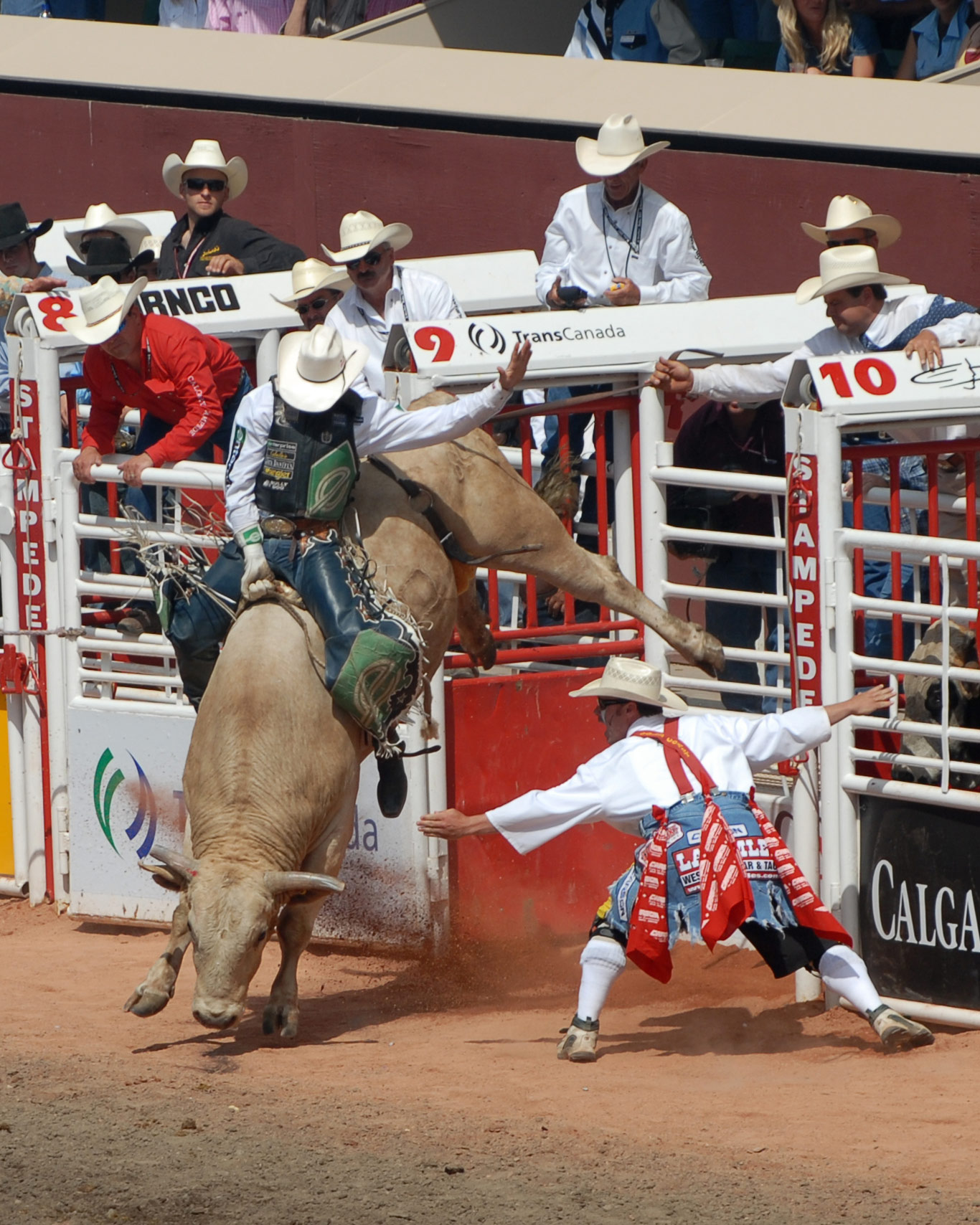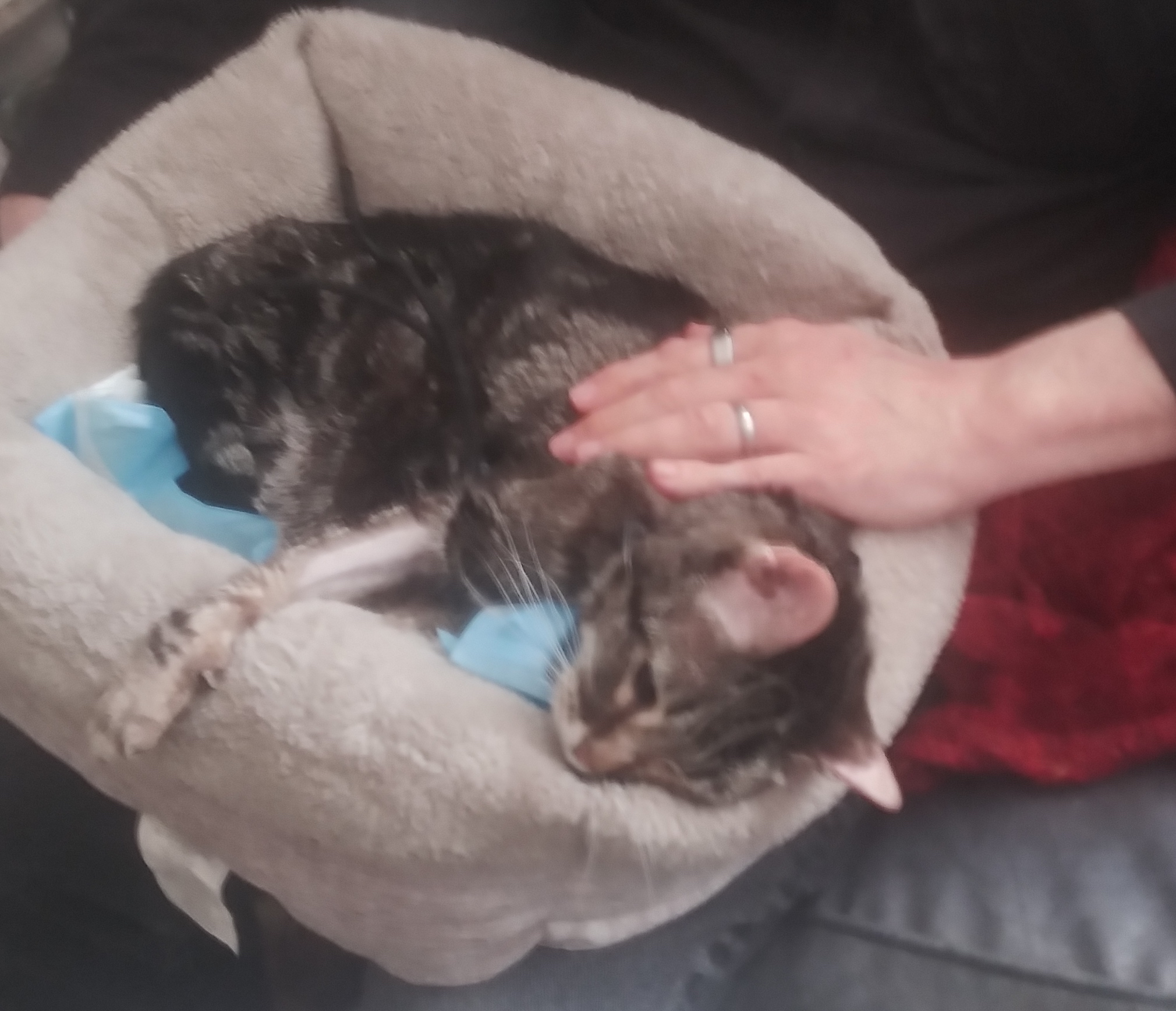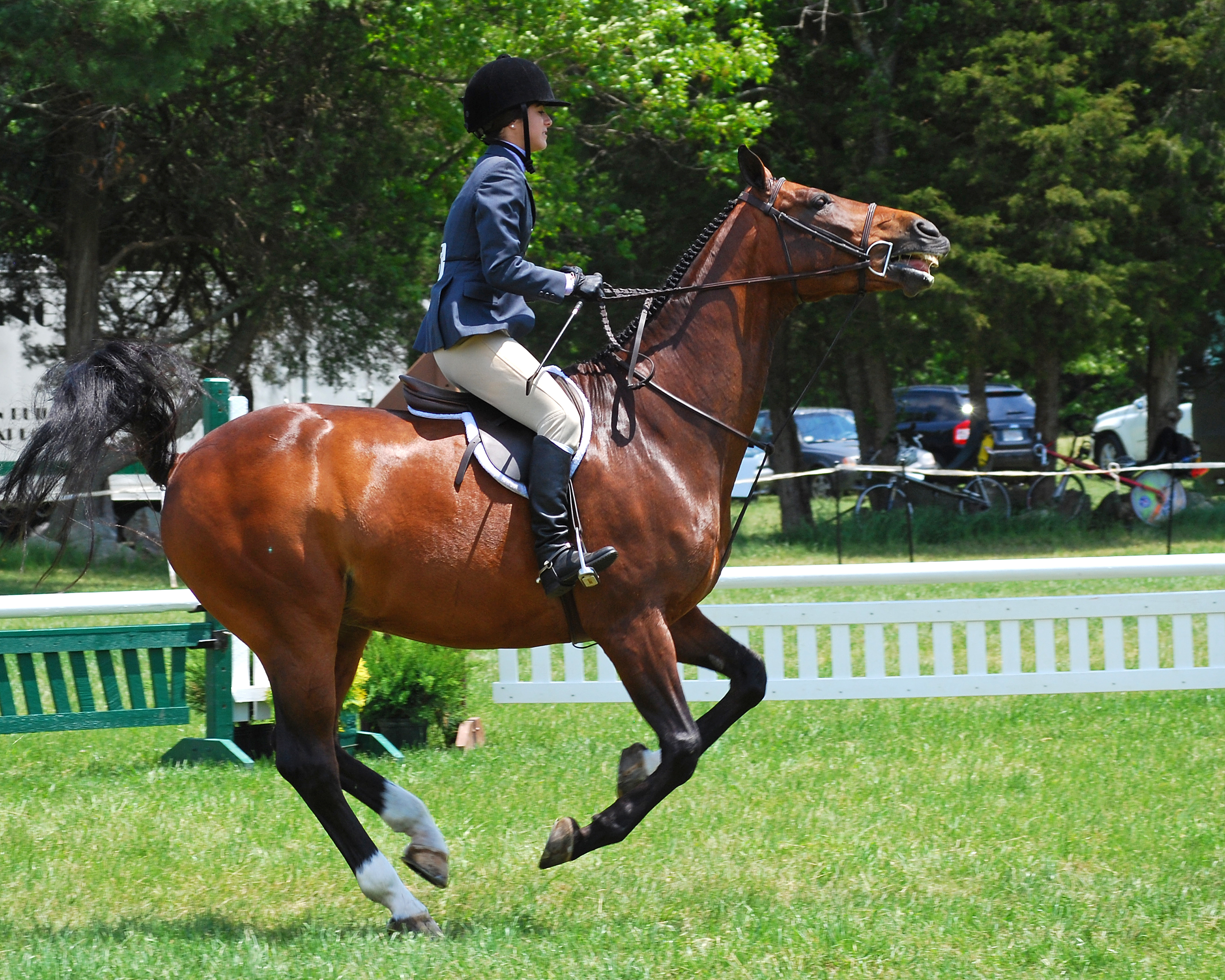|
Bucking
Bucking is a movement performed by an animal in which it lowers its head and raises its hindquarters into the air while kicking out with the hind legs. It is most commonly seen in herbivores such as equines, cattle, deer, goats, and sheep. Most research on this behavior has been directed towards horses and cattle. Bucking can vary in intensity from the animals' slight elevation of both hind legs, to lowering their head between their front legs, arching their back, and kicking out several times. Originally, it was predominantly an anti-predator and play behavior, but with domestication, it is now also a behavioral issue in riding horses, and a desired behavior in bucking horses and bulls. If powerful, it may unseat or even throw off a rider, and can seriously injure either animal, rider, or both. Reasons for bucking Bucking, though a potentially dangerous disobedience when under saddle, is a natural aspect of horse behavior. Bucking is used by animals for several reasons. I ... [...More Info...] [...Related Items...] OR: [Wikipedia] [Google] [Baidu] |
Bucking Horse
A bucking horse is any breed of horse, male or female, with a propensity to bucking, buck. They have been, and still are, referred to by various names, including bronco, broncho, and roughstock. The harder they buck, the more desirable they are for rodeo events. Roughstock breeders have long established strings of bucking horses with mare, broodmares and stallions that have been Breed, bred and Crossbreed, crossbred to more consistently produce the desired temperaments and athletic ability needed for bronc riding, bareback and saddle bronc riding competition. Bareback broncs are typically smaller, faster athletes whereas saddle broncs are heavier bodied athletes of great strength and endurance. History Etymology The term comes from the Spanish language word ''bronco'' meaning "rough" (adj), or "gruff" (n), which in Mexican Spanish, Mexican usage also describes the horse. It was borrowed and adapted in U.S. cowboy jargon. It has also been spelled "broncho", though this f ... [...More Info...] [...Related Items...] OR: [Wikipedia] [Google] [Baidu] |
Bucking Bull
A bucking bull is a bull used in rodeo bull riding competition. They are usually a Brahman crossed with another breed, weighing 1,500 pounds or more, selected for their tendency to "leap, plunge and spin" when a human is on its back. In the mid-20th century, breeders began selecting bulls for bad temperament; ones that would buck when ridden. Many of the best bucking bulls trace their lineage to bulls owned by Charlie Plummer of Oklahoma. These are known as Plummer bulls. Bucking bulls are viewed as athletes. They usually are started in their bucking career at the age of two or three, reach their athletic prime at age five or six, and if they remain healthy, can continue bucking at least until the age of 10, sometimes longer. In some competitions between bulls, with a purse amounting to tens of thousands of dollars per event, the bulls are ridden by electronic dummies, not rodeo bull riders. Good performing bulls attain a celebrity status and can be considered a star athle ... [...More Info...] [...Related Items...] OR: [Wikipedia] [Google] [Baidu] |
Bareback Bronc
Bronc riding, either bareback bronc or saddle bronc competition, is a rodeo event that involves a rodeo participant riding a bucking horse (sometimes called a ''bronc'' or ''bronco'') that attempts to throw or buck off the rider. Originally based on the necessary buck breaking skills of a working cowboy, the event is now a highly stylized competition that utilizes horses that often are specially bred for strength, agility, and bucking ability. It is recognized by most rodeo organizations such as the Professional Rodeo Cowboys Association (PRCA) and the International Professional Rodeo Association (IPRA). Description Each competitor climbs onto a horse, which is held in a small pipe or wooden enclosure called a bucking chute. When the rider is ready, the gate of the bucking chute is opened and the horse bursts out and begins to buck. The rider attempts to stay on the horse for eight seconds without touching the horse with their free hand. On the first jump out of the chute, the ... [...More Info...] [...Related Items...] OR: [Wikipedia] [Google] [Baidu] |
Animal Euthanasia
Animal euthanasia (euthanasia from ; "good death") is the act of killing an animal humanely, most commonly with injectable drugs. Reasons for euthanasia include incurable (and especially painful) conditions or diseases, lack of resources to continue supporting the animal, or laboratory test procedures. Euthanasia methods are designed to cause minimal pain and distress. Euthanasia is distinct from animal slaughter and pest control. In domesticated animals, the discussion of animal euthanasia may be substituted with euphemisms, such as "put down" or "put to sleep" to make the wording less harsh. Methods The methods of euthanasia can be divided into pharmacological and physical methods. Acceptable pharmacological methods include injected drugs and gases that first depress the central nervous system and then cardiovascular activity. Acceptable physical methods must first cause rapid loss of consciousness by disrupting the central nervous system. The most common methods are discus ... [...More Info...] [...Related Items...] OR: [Wikipedia] [Google] [Baidu] |
Horse Training
Horse training refers to a variety of practices that teach horses to perform certain behaviors when commanded to do so by humans. Horses are trained to be manageable by humans for everyday care as well as for equestrianism, equestrian activities, ranging anywhere from equine sports such as horse racing, dressage, or jumping, to therapeutic horseback riding for people with disabilities. Historically, horses were trained for war horse, warfare, farm work, sport and transport purposes. Today, most horse training is geared toward making horses useful for a variety of recreational and sporting equestrian pursuits. Horses are also trained for specialized jobs from movie stunt work to police and crowd control activities, circus entertainment, and equine-assisted psychotherapy. There is controversy over various methods of horse training and even some of the words used to describe these methods. Some techniques are considered cruel and others are considered humane. Goals The range of t ... [...More Info...] [...Related Items...] OR: [Wikipedia] [Google] [Baidu] |
Habituation
Habituation is a form of non-associative learning in which an organism’s non-reinforced response to an inconsequential stimulus decreases after repeated or prolonged presentations of that stimulus. For example, organisms may habituate to repeated sudden loud noises when they learn that these have no consequences. Habituation can occur in responses that habituate include those that involve an entire organism or specific biological component systems of an organism. The broad ubiquity of habituation across all forms of life has led to it being called "the simplest, most universal form of learning...as fundamental a characteristic of life as DNA." Functionally, habituation is thought to free up cognitive resources for other stimuli that are associated with biologically important events by diminishing the response to inconsequential stimuli. A progressive decline of a behavior in a habituation procedure may also reflect nonspecific effects such as fatigue, which must be ruled ... [...More Info...] [...Related Items...] OR: [Wikipedia] [Google] [Baidu] |
Bearing Rein
The Bearing rein also called a check rein or overcheck, is a type of rein attached to the bit on a bridle, that runs over the head of the horse, attaching to the harness saddle or pad. The primary purpose of a bearing rein is to prevent the horse from lowering its head. The secondary purpose is to raise the horse's head to a higher position for aesthetic reasons. A bearing rein is not held in the driver's hand and thus does not direct the horse to turn, slow down, or stop. It can be attached to the same bit as the reins used to control and direct the horse, or to a second, separate bit sometimes called a bradoon. Description There are several variations, but all bearing reins start by connecting to the horse's bit or a separate small bradoon bit, then reach to a ring or hook at the center of the harness saddle or pad, called a ''pad hook'' or ''bolt hook''. Bearing reins are optional in harness driving, however when using them the harness must have a crupper to keep the harn ... [...More Info...] [...Related Items...] OR: [Wikipedia] [Google] [Baidu] |
Martingale (tack)
A martingale is any of several designs of horse tack, tack that are used on horses to control head carriage. Martingales may be seen in a wide variety of equestrianism, equestrian disciplines, both riding and driving (horse), driving. Rules for their use vary widely; in some disciplines they are never used, others allow them for schooling but not in judged performance, and some organizations allow certain designs in competition. The two most common types of martingale, the standing and the running, are used to control the horse's head height, and to prevent the horse from throwing its head so high that the rider loses control over the horse's speed, direction and shape of body. When a horse's head gets above a desired height, the martingale places pressure on the head so that it becomes more difficult or impossible to raise it higher. The standing martingale The standing martingale, also known as a "tiedown" or a "head check",The Pony Club Association of NSW, "Handbook", Sim ... [...More Info...] [...Related Items...] OR: [Wikipedia] [Google] [Baidu] |
Gag Bit
The gag bit is a type of bit for a horse with sliding cheekpieces of rolled leather or chord that run through the bit rings, providing leverage that pulls the bit up into the corners of the horse's mouth. It is considered a severe bit used to provide more braking power. Some styles of gag bit are integral to a special bridle, known as a gag bridle; others are used with a standard bridle. Inside the horse's mouth, the gag bit may be jointed like a snaffle bit or smooth like a Mullen mouth bit. Usage The gag bit works on the horse's lips and poll simultaneously. The pressure on the lips tends to make the horse raise its head, which is useful for a horse that tends to lean on the bit. Gag bits are used mainly for horses that are strong pullers or for horses that need retraining. Gag bits are most commonly seen in polo, eventing (especially for cross-country), show jumping, and hacking, mainly for increased control at times where a horse may be excited or try to run of ... [...More Info...] [...Related Items...] OR: [Wikipedia] [Google] [Baidu] |
Positive Punishment
Punishment is any change in a human or animal's surroundings which, occurring after a given behavior or response, reduces the likelihood of that behavior occurring again in the future. Reinforcement, referring to any behavior that increases the likelihood that a response will occurs, plays a large role in punishment. Motivating operations (MO) can be categorized in abolishing operations, decrease the effectiveness of the stimuli and establishing, increase the effectiveness of the stimuli. For example, a painful stimulus which would act as a punisher for most people may actually reinforce some behaviors of masochistic individuals. There are two types of punishment: positive and negative. Positive punishment involves the introduction of a stimulus to decrease behavior while negative punishment involves the removal of a stimulus to decrease behavior. While similar to reinforcement, punishment's goal is to decrease behaviors while reinforcement's goal is to increase behaviors. Differ ... [...More Info...] [...Related Items...] OR: [Wikipedia] [Google] [Baidu] |
Longeing
Longeing (US English, classical spelling) or lungeing (UK English, informal US) is a technique for training and exercising horses where the horse travels in a circle around the handler. It is also a critical component of the sport of equestrian vaulting. The horse is asked to work at the end of a long line of approximately . Longeing is performed on a large circle with the horse traveling around the outside edge of a real or imaginary ring with the handler on the ground in the center, holding the line. The horse is asked to respond to commands from the handler or trainer, usually given by voice, aided by pressure and release of the line and movement of a whip with a long shaft and equally long lash, called a longeing whip or longe whip. Longeing is used as a training tool for young horses to introduce them to commands, equipment, and to build trust and respect in the trainer. It can also be used to good effect to build strength in ridden horses or for rehabilitation after illn ... [...More Info...] [...Related Items...] OR: [Wikipedia] [Google] [Baidu] |









